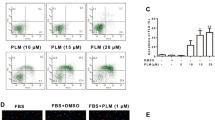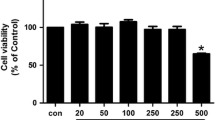Abstract
CD147 expressed by monocytes, macrophages, and synoviocytes cells can stimulate the production of matrix metalloproteinases (MMPs) associated with the development of rheumatoid arthritis (RA). We investigated the effects of Sinomenine (SIN) on invasion and migration ability and gene expression of CD147, MMP-2, MMP-9 of fibroblast-like synoviocytes cells (FLS) co-cultured with activated human monocytic THP-1 cells (A-THP-1) in vitro. SIN is a pure alkaloid extracted from the Chinese medical plant Sinomenium acutum. FLS cells were co-cultured with THP-1 cells which were induced to differentiate into macrophages with phorbol 12-myristate 13-acetate (PMA). Cells were treated with different concentrations of SIN. Invasion and migration ability of cells was tested by transwell assays. Western blot analysis and zymographic analysis were adopted to detect the expression of CD147 and MMPs, respectively. RT–PCR was used to determine the expression of mRNA of CD147, MMP-2, and MMP-9. The invasion and migration ability of the co-cultured cells was significantly inhibited by SIN in a concentration-dependent fashion, and at the same time, the levels of CD147, MMP-2, MMP-9 were markedly down-regulated. This inhibitory effect was most notable at concentrations of 0.25 and 1.00 mM (P < 0.01). Our results point to a possible mechanism of SIN on treatment of RA is the inhibitory effect of SIN on cell invasion and migration ability, which strongly correlates with repressing the expression of CD147, MMP-2, and MMP-9.





Similar content being viewed by others
References
Ke XY, Xiu MX (1986) Treatment of rheumatoid arthritis by sinomenine. Beijing Yixue 3:186–187
Shi PM, Ma ZX, Zhang WZ (1985) History of Chinese medicine. Xien Yi Xue 3:292–293
Liu ZQ, Kelvin C, Zhou H, Jiang ZH, Wong WF (2005) The pharmacokinetics and tissue distribution of sinomenine in rats and its protein binding ability in vitro. Life Sci 77:3197–3209
Noriaki N, Takashi F, Yoshimasa I, Shigeyuki U, Kazuyuki H (2009) Preventive effect of co-administration of water containing magnesium ion on indomethacin induced lesions of gastric mucosa in adjuvant-induced arthritis rat. Biol Pharm Bull 32:116–120
Li XJ, Patrick YK, Ha WY, Daisy YL, Mandy MY, Wang PX (2006) Effect of sinomenine on gene expression of the IL-1β-activated human synovial sarcoma. Life Sci 79:665–673
Yamasaki H (1976) Pharmacology of sinomenine, an anti-rheumatic alkaloid from Sinomenium acutum. Acta Med Okayama 30:1–20
Li F, Li XF, Hu XF (2005) The serum matrix metalloproteinase- 9 level and it′s significance in rheumatoid arthritis. Chin J Rheumatol 9:9–11
Eric EG, Thanh HX, Alain M, Suzanne M (2005) EMMPRIN/CD147, an MMP modulator in cancer, development and tissue repair. Biochimie 87:361–368
Liu JH, Li WD, Teng HL, Lin ZB (2005) Immunopharmacological action of sinomenine, an alkaloid isolated from Sinomenium acutum, and its mechanism of action in treating rheumatoid arthritis. Acta Pharmaceu Sin 40:127–131
Liu L, Buchner E, Beitze D, Schmidt CB, Kaever V, Emmrich F (1996) Amelioration of rat experimental arthritides by treatment with the alkaloid sinomenine. Int Immunopharmacol 18:529–543
Kok TW, Yue PY, Mak NK, Fan TP, Liu L, Wong RN (2005) The anti-angiogenic effect of sinomenine. Angiogenesis 8:3–12
Wu ZB, Zhu P, Lu N, Shi ZG, Fan CM, Wang YH (2005) Enhanced production of MMP-2, MMP-9 by fibroblast cells from rheumatoid arthritis patients when co-cultured with monocytes of high CD147 expression. Chin J Rheumatol 5:26–27
Ou YQ, Chen LH, Li XJ, Lin ZB (2009) Sinomenine influences invasion and migration ability by inhibiting the expression of MMP-2, MMP-9, CD147 in activated human monocytic THP-1 cells. Acta Pharmacol Sin 30:435–441
Tae H, Kim KW, Suh SJ, Kwak CG, Kima JK, Kimb CH (2007) Inhibitory effect of Uncaria sinensis on human aortic smooth muscle cell migration is based on matrix metalloproteinase-9 inhibitory. Environ Toxicol Phar 24:218–222
Jin MH, Yang JH, Lee E, Lu Y, Kwon S, Son KH, Son JK, Chang HW (2009) Antiasthmatic activity of luteolin-7-O-glucoside from Ailanthus altissima through the downregulation of T helper 2 cytokine expression and inhibition of prostaglandin E2 production in an ovalbumin-induced asthma model. Biol Pharm Bull 32:1500–1503
Kuang YH, Chen X, Su J, Wu LS, Liao LQ, Li D, Chen ZS, Takuro K (2008) RNA interference targeting the CD147 induces apoptosis of multi-drug resistant cancer cells related to XIAP depletion. Cancer letter 10:10–16
Sun X, Zhang XD, Hu H, Lu Y, Chen J, Yasuda K, Wang H (2009) Berberine inhibits hepatic stellate cell proliferation and prevents experimental liver fibrosis. Biol Pharm Bull 32:1533–1537
Kataoka H, DeCastro R, Zucker S, Biswas C (1993) Tumor cell-derived collagenase -stimulatory factor increases expression of interstitial collagenase, stromelysin, and 72-kDa gelatinase. Cancer Res 53:3154–3158
Huber LC, Distler O, Tarner I, Gay RE, Gay S, Pap T (2006) Synovial fibroblasts: key players in rheumatoid arthritis. Rheumatology 45:669–675
Pap T, Gay S, Schett G (2002) Matrix metalloproteinases. In: Smolen J, Lipsky J, Dunitz M (eds)Targeted therapies in rheumatology, pp 483–497
Amorino GP, Hoover RL (1998) Interactions of monocytic cells with human endothelial cells stimulate monocytic metalloproteinase production. Am J Pathol 152:199–207
Guo H, Zucker S, Gordon MK, Toole BP, Biswas C (1997) Stimulation of matrix metalloproteinase production by recombinant extracellular matrix metalloproteinase inducer from transfected Chinese hamster ovary cells. J Biol Chem 272:24–27
Sun J, Hemler ME (2001) Regulation of MMP-1 and MMP-2 production through CD147/extracellular matrix metalloproteinase inducer interactions. Cancer Res 61:2276–2281
Biswas C, Zhang Y, DeCastro R, Guo H, Nakamura T, Kataoka H, Nabeshima K (1995) The human tumor cell-derived collagenase stimulatory factor (renamed EMMPRIN) is a member of the immunoglobulin superfamily. Cancer Res 55:434–439
Guo H, Majmudar G, Jensen TC, Biswas C, Toole BP, Gordon MK (1998) Characterization of the gene for human EMMPRIN, a tumor cell surface inducer of matrix metalloproteinases. Gene 220:99–108
Liang L, Terry M, Thomas B (2002) Characterization of the promoter of human extracellular matrix metalloproteinase inducer (EMMPRIN). Gene 282:75–86
Dong WJ, Zhu P, Fan CM, Wang YH, Xiao LB (2004) Expression of CD147 and matrix metalloproteinases in rheumatoid synovium. Chin J Rheumatol 8:135–138
Acknowledgments
The authors are very grateful to Dr. Michael A. McNutt and Dr. xiaoling-ZHU for revising this paper.
Author information
Authors and Affiliations
Corresponding author
Rights and permissions
About this article
Cite this article
Ou, Y., Li, W., Li, X. et al. Sinomenine reduces invasion and migration ability in fibroblast-like synoviocytes cells co-cultured with activated human monocytic THP-1 cells by inhibiting the expression of MMP-2, MMP-9, CD147. Rheumatol Int 31, 1479–1485 (2011). https://doi.org/10.1007/s00296-010-1506-2
Received:
Accepted:
Published:
Issue Date:
DOI: https://doi.org/10.1007/s00296-010-1506-2




